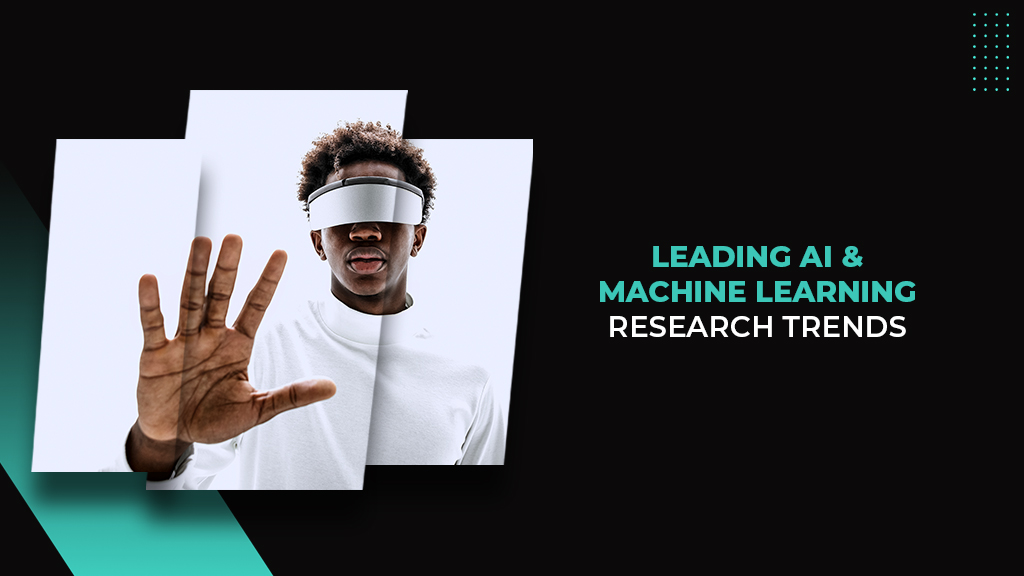Leading AI & Machine Learning Research Trends
The “learning” in machine learning refers to a process in which machines review existing data and learn new skills and knowledge from that data, ML aims to teach machines to systematically perform cognitive activities, similar to the human mind. These systems use algorithms to find patterns in datasets and are computationally intensive, requiring specialized IT infrastructure to run at a large scale.
In 2021, recent innovations in machine learning have made many tasks more feasible, effcient, and precise than ever before. Businesses and organizations are coming to understand that a robust Machine learning strategy will improve the performance, scalability, interpretability, and reliability and deliver the full value of new technology investments
In this article, we have summarized the latest Machine learning technology trends across different areas, including hyper-automation, natural language processing, conversational AI, and Deep Learning.
1.
Hyper-automation:
Gartner named hyper-automation the first trend that would transform the world, as hyper-automation comes in many shapes and forms that seem very natural and ubiquitous nowadays, It becomes not just about the execution of tasks, but the optimization of the best ways to complete them.
The question and one of the biggest debates is whether automation will replace humans as workforce, however, this trend is the exact opposite: it is to enable humans to fulfill their potential by focusing on high-involvement tasks and augment human capabilities to produce high-quality and highly specialized work. The same response applies to hyper-automation, however, hyper-automation brings the question of whether the business is ready to adopt a smart, AI-driven automation process that will operate in assistance to — and on par with — the human counterparts,
Automated business processes must be able to adapt to changing circumstances and respond to unexpected situations thus machine-learning models and deep learning technology need to be implemented as the core of hyper- automation is the right combination of a variety of tools connected by superior AI intelligence.
Depending on the end goal of the organization, In machine learning, there are three paradigms: supervised learning, unsupervised learning, and reinforcement learning.
2.
Natural Language Processing:
Natural language processing or NLP makes sense of human language so that it can automatically perform different tasks. NLP analyzes the grammatical structure of sentences and the individual meaning of words, simply put NLP makes it possible for computers to understand the human language. you’ve probably encountered NLP without even noticing some of it.
Text recommendations when writing an email, offering to translate a google post written in a different language, or filtering unwanted promotional emails into your spam folder. In essence, the role of machine learning and AI in NLP and text analytics is to improve, accelerate and automate the underlying text analytics into useable data and insights.
One practical example of an organization using NLP is the Verizon Business Service Assurance group, which utilizes NLP and deep learning to automate the processing of customer request comments. AI-Enabled Digital Worker for Service assurance reads repair tickets and automatically responds to the most common requests, such as reporting on current ticket status or repair progress updates.
3.
Conversational AI:
Similar to Natural language processing, Conversational AI has principle components that allow it to process, understand, and generate a response in a natural way.
IBM’s definition of Conversational artificial intelligence (AI) refers to technologies, like chatbots or virtual agents, which users can talk to. They use large volumes of data, machine learning, and natural language processing to help imitate human interactions, recognizing speech and text inputs and translating their meanings across various languages.
Conversational AI is a cost-effcient solution for many business processes, while it also Increased sales, customer engagement, and scalability, businesses need to be prepared to provide real-time information to their end-users.
Since customers can engage more quickly and frequently with brands, conversational AI tools provide the solution to customers’ long call center wait times. allowing businesses to cross-sell products that customers may not have initially considered, It also helps when products expand to new geographical markets.
While most AI chatbots and apps currently have basic problem-solving skills, they can reduce time and improve cost effciency on repetitive customer support interactions, freeing up personnel resources to focus on more involved customer interactions. Overall, conversational AI apps have been able to replicate human conversational experiences well, leading to higher rates of customer satisfaction.
4.
Deep Learning:
Deep learning algorithms run data through several “layers” of neural network algorithms, each of which passes a simplified representation of the data to the next layer. Deep learning can be considered as a subset of machine learning. It is a field that is based on learning and improving on its own by examining computer algorithms, deep learning works with artificial neural networks, which are designed to imitate how humans think and learn.
Most machine learning algorithms work well on datasets that have up to a few hundred features. However, an unstructured dataset. Deep learning algorithms learn progressively more about the image as it goes through each neural network layer. Early layers learn how to detect low- level features like edges, and subsequent layers combine features from earlier layers into a more holistic representation.
Deep-learning represents a truly disruptive digital technology, and it is being used by increasingly more companies to create new business models.
Various methods can be used to create strong deep learning models. These techniques include learning rate decay, transfer learning, training from scratch, and dropout.
The learning rate decay:
is the process of adapting the learning rate to increase performance and reduce training time.
Transfer learning:
This method has the advantage of requiring much less data than others, thus reducing computation time to minutes or hours, it involves perfecting a previously trained model, an interface to the internals of a pre-existing network then feeding the existing network new data containing previously unknown classifications. Once adjustments are made to the network, new tasks can be performed with more specific categorizing abilities.
Training from scratch:
This method requires inordinate amounts of data, causing training to take days or weeks. a developer will have to collect a large labeled data set and configure a network architecture that can learn the features and model. This technique is especially useful for new applications, as well as applications with a large number of output categories.
Dropout.
This method attempts to solve the problem of overfitting in networks with large amounts of parameters by randomly dropping units and their connections from the neural
network during training, It has been proven that the dropout method can improve the performance of neural networks on supervised learning tasks in areas such as speech recognition, document classification, and computational biology.
Because deep learning models process information in ways similar to the human brain, they can be applied to many tasks, most common image recognition tools, natural language processing (NLP), and speech recognition software.
These tools are starting to appear in applications as diverse as self-driving cars and language translation services.
Conclusion
Every objective listed above requires different methods to achieve. Talking to experts about what’s best for your company can help you understand what technologies, such as machine learning, can improve the effciency of your business and help you achieve your vision.
If you have questions about the technology discussed here and how it can best be applied to your business, please reach out to our OGT team.


